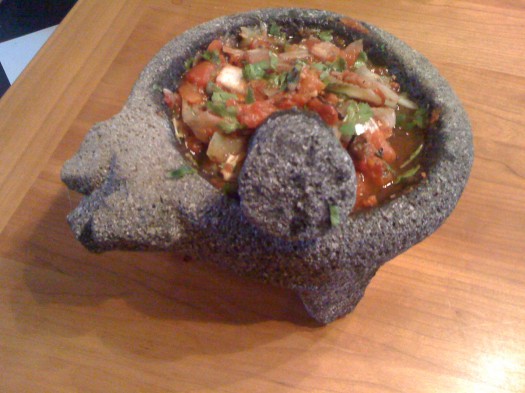Food: David’s molcajete, ancient cookware for mean salsas
April 9, 2010
David’s 35th birthday was last week. After my first four gift ideas went wholly south, I decided to get him something he’d been asking for. Well, sort of. Our kitchen’s mortar and pestle complement was sorely lacking. Our little guy only held a few ounces and served more to spray bits of things around than to crush or muddle them usefully. David had, for some time, been on the warpath for a new mortar and pestle, a big, manly, indestructible one.
I took it a bit further and found something shaped like a pig. Instead of an outsized marble variant or, even less usefully, a ceramic one, I found a jumbo-sized Mexican molcajete. These three-footed vessels are traditionally made from volcanic rock, tend to shed dust and grit until they’re seasoned, and have been around in some way or another since the Aztecs ruled Tenōchtitlān, awesome calendaring system and all.
Like cast iron skillets, molcajetes often require seasoning. The primary goal of this is to reduce the amount of grit one has to endure in the finished salsas and guacamoles. One method for doing this involves grinding handfuls of uncooked rice until it no longer turns gray (yum). Other seasoning involves unavoidable reality: the porous surface of the stone absorbs the many generations of salsa in its history. Just like the onions and garlic make my own breath a special kind of miasma the day after a big salsa-fest, so too the aromas and pep linger in the molcajete itself.
Homesick Texan has a detailed, bemusing post about obtaining and seasoning a molcajete. I will say that I did obtain David’s molcajete at a national chain, albeit a foofy national chain. I verified that it is definitely only volcanic rock (traditionally basaltic; definitely not adulterated with concrete as are some of the less-nice molcajete knock-offs out there). It claimed to be pre-seasoned, and, indeed, when David tried the rice-grinding method, the rice stayed white.
Once David perfects the transition of his super-duper personal salsa recipe to the molcajete—right now there is still some learning involving how small to cut things up before pounding—we’ll let you know.

Last night's salsa in the molcajete.
Related Posts
- Food: One dough to rule them all
January 13, 2010 - Analytic Tuna Fish
July 10, 2008 - Artifacts
June 17, 2008 - The Duck Drama, Post 1 of Perhaps 2 if Everything Goes Right
June 4, 2008 - An Unfortunate Development
June 17, 2008
